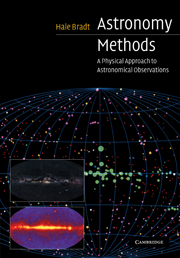Book contents
- Frontmatter
- Contents
- List of figures
- List of tables
- Preface
- Acknowledgments
- 1 Astronomy through the centuries
- 2 Electromagnetic radiation
- 3 Coordinate systems and charts
- 4 Gravity, celestial motions, and time
- 5 Telescopes
- 6 Detectors and statistics
- 7 Multiple telescope interferometry
- 8 Point-like and extended sources
- 9 Properties and distances of celestial objects
- 10 Absorption and scattering of photons
- 11 Spectra of electromagnetic radiation
- 12 Astronomy beyond photons
- Credits, further reading, and references
- Appendix: Units, symbols, and values
- Index
5 - Telescopes
Published online by Cambridge University Press: 05 June 2012
- Frontmatter
- Contents
- List of figures
- List of tables
- Preface
- Acknowledgments
- 1 Astronomy through the centuries
- 2 Electromagnetic radiation
- 3 Coordinate systems and charts
- 4 Gravity, celestial motions, and time
- 5 Telescopes
- 6 Detectors and statistics
- 7 Multiple telescope interferometry
- 8 Point-like and extended sources
- 9 Properties and distances of celestial objects
- 10 Absorption and scattering of photons
- 11 Spectra of electromagnetic radiation
- 12 Astronomy beyond photons
- Credits, further reading, and references
- Appendix: Units, symbols, and values
- Index
Summary
What we learn in this chapter
Telescopes and antennas collect photons, and the detectors at their foci record the information content of the radiation, its intensity and polarization as a function of time, and also its frequency distribution and direction of arrival. There are several common configurations of optical telescopes. Focal length and aperture determine the plate scale, sensitivity and potential resolution of the telescope. Non-focusing instruments are used by gamma-ray astronomers while x-ray astronomers use both focusing and non-focusing systems. Telescope resolution may be limited by diffraction. The point-spread function describes the shape of the (single pixel) telescope beam. The resolution of large ground-based optical telescopes is severely limited by non-planar wavefronts caused by atmospheric turbulence. Speckle interferometry and adaptive optics are techniques for overcoming this limitation.
Introduction
The systems that extract information from faint signals about distant celestial bodies are the source of essentially all our astronomical knowledge. Telescopes collect and concentrate the radiation, and the instruments at their foci analyze one or more properties of the radiation. The systems used for the various frequency bands (e.g., radio, optical, and x-ray) differ dramatically from one another.
The faint signals must compete with background noise from the cosmos, the atmosphere, the earth's surface, and the detectors themselves. These noise sources differ with the frequency of the radiation. Advances in astronomy often follow from improved rejection of noise so that fainter signals can be detected.
Information
- Type
- Chapter
- Information
- Astronomy MethodsA Physical Approach to Astronomical Observations, pp. 98 - 129Publisher: Cambridge University PressPrint publication year: 2003
